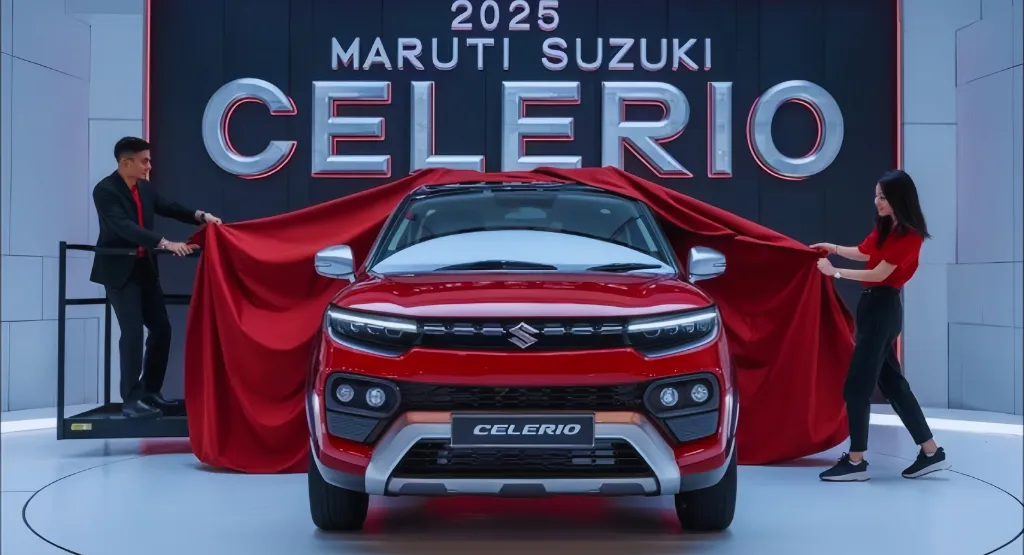Last but not the least from the ever-changing products line-up i.e automotive offerings, entry-level hatchback segment in India steps in as the most important rung in ownership ladder for salivating new motorists in large numbers.
This is where the problem of what to pair affordable and actual decent in becomes potentially the tougher yet most important balance. As a much more reimagined solution, the new Suzuki Celerio appears to be an outright revolution for cheap motoring compromises.
New Suzuki Celerio – A Different spin On The Original
Perhaps the most visceral, and up front change in this new wave of car is on the Celerio.
Its predecessor may have been a utilitarian generic-number, something to be had but easily forgotten; the successor opts for choreography and wants acknowledgement without design excess.
The front fender has taken a braver approach with a hexagonal grille in the mien from round edged-at the ends headlamps sliding in and making it look wider and more grounded.
Wheelhouse (the most noticeable proportional change), wider track provides much better interior space as well more even styling profile. Greenhouse is good to look out and the greenhouse adds a touch more dynamic into the profile which flows up towards rear to lower the apparent height with the same headroom.
Groove in the wheel arches are more developed, expecting larger 15” wheel at improved scant higher trims that was originally rather small wells (before now were reality).
Cabin Revolution: blending space with sensibility
When you open the door of the all-new Celerio, transformation is palpable. For the first time, the dashboard design steps away from pure utilitarian architecture in favor (as seen elsewhere) of something more naturalistic and tactile integrated with soft-touch on key high contact surfaces.
Intended to echo premium design cues, the circular air vent at the extremities of this package serve not only great looks but proper cabin ventilation, too.
In the middle of the console, for example: 7-inch touch screen infotainment system (on all overzetting except the base variant; which instead has a rather bare bones touchscreen with both wireless Apple CarPlay, and Android Auto, technologies not found even on some mid-segment cars just a few years ago.
Also as part of that screen serves the rear camera, yet another concept which was once reserved only for cars costing more than double what you pay for this.

From basic analog dials, instrumentation has been upgraded to a digital speedo mounted centrally with dual-analog fuel and temperature gauge setup.
It is a very balanced arrangement because the digital bit gives you dials that carry different info rates which can be selected using buttons mounted on a steering wheel.
Probably most notably, there is a fairly substantial gain in useable interior space despite small changes to external dimensions. The stretched wheelbase and slightly sculpted front seats stretch legroom by about 26mm, say Rytec.
Powertrain Refinement: No Sacrifice of Brilliance
Under the hood it sports Suzuki′s latest K10C DualJet engine—a completely new 1.0 litre three-cylinder reinvention denoting the new Celerio (Introducing latest baby in the line-up).
DualInjectors per cylinder of powerplant means improved fuel atomization for clean burning, but reduced carbon that will set in over time (and kill an engine).
67 horsepower and 89 Nm of torque: output figures that are not exactly eye-popping but reasonable given the 825 kilograms this car weighs.
More than the actual numbers matters is the engine personality, a torque that lingers until 3,500 revs and a long broadband spread in general which is good for you to drive hard on any terrain.
Enhancements have already been made to vibration management—with a new balanced crankshaft and engine mounting system that substantially damps out harshness from the cabin in connection to the transmission.
A five-speed manual and an automatic gear shift (AMT) option has been added to the range, meanwhile; it gets a refined Auto Manual transmission—the company calls this one, interestingly enough nothing but ‘Auto Gear Shift’
[ The Manual gets something neck-rubbing with its lighter clutch and shorter throw, while the AMT goes through extensive calibration fixes that remove much of the feel-related lag that defined this technology in its previous incarnations.
This latest AMT implementation falls short of a true traditional automatic or CVT, but serves as a pragmatic pathway in addressing cost needs with real usability improvements.
The headline power figure that will get a lot of buyers turning knobs is the fine fuel economy. Intro variant will get 15% better than before at 26.68 kilometers per liter with procedure and external standards for the manual transmission.
Enhancing Safety Standards
Perhaps the most important move is to standard safety components.
With safety equipment standardization, as the most important stride.
Suzuki has also taken the step of standardisation across all Celerio variants, gear with dual front airbags; ABS with EBD and electronic stability control — marking a new norm in the segment where top trims often do not even offer this to customers/rides.
The body structure is based on HEARTECT platform fundamentals of strategic crumple zones reinforcement and optimized energy dispersal paths during impact.
Introduction of a new Suzuki Celerio-Redefining
The Celerio could be more than just a bandied away iteration of an old nameplate.
At its core, we are commoditizing what an entry-level car should look like in terms of design luxury, tech integration, efficiency performance and safety.
While in the past generations, it used to be “how can we make this affordable?”, this one exposes its answer from the opposite side: “what quality can we deliver here for this price?” This answer is as spectacularly rich, with just a few crafty things sprinkled throughout ensuring the ownership experience just feels better than veering around on four wheels.




